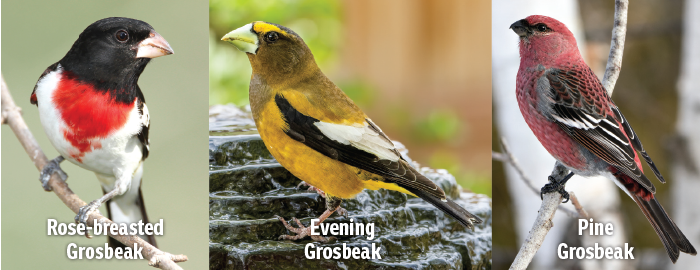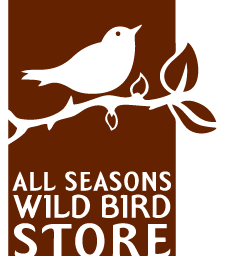FROM THE MAY/JUNE 2025 BIRD’S-EYE VIEW NEWSLETTER
Minnesota is home to several species of grosbeaks, striking songbirds known for their thick, seed-cracking bills. Here’s a look at a few species you may encounter in your backyard or while exploring the outdoors.
What Is a Grosbeak?
Grosbeaks are birds named for their large, thick bills; a name derived from the French phrase meaning “large beak.” Despite their shared name, grosbeaks belong to different families. Rose-breasted and Black-headed Grosbeaks are cardinals, Evening and Pine Grosbeaks are finches, and the Blue Grosbeak is related to buntings.
Which Grosbeaks Are Common in Minnesota?
Minnesota is home to three commonly observed grosbeak species: the Rose-breasted Grosbeak, the Evening Grosbeak, and the Pine Grosbeak. Rose-breasted Grosbeaks are regular spring migrants, seen throughout the state, and are most frequently found in deciduous forests where they breed during the summer months. Evening Grosbeaks are most often spotted in the northern and northeastern parts of Minnesota, particularly in winter, though during irruption years, they may extend their range farther south in search of food. Pine Grosbeaks, another winter visitor, are typically found in the north and northeast, where they forage on fruiting trees and seeds.
Two other grosbeak species are less commonly seen in the state. The Black-headed Grosbeak (shown) was last recorded in Minnesota in 2015, making it a rare visitor. The Blue Grosbeak is occasionally spotted in the far southwest corner of the state, primarily during spring and fall migration, though some remain to nest during the summer.
 How Do Minnesota’s Grosbeaks Differ?
How Do Minnesota’s Grosbeaks Differ?
Among the grosbeaks found in Minnesota, the Pine Grosbeak and Evening Grosbeak belong to the finch family, while the Rose-breasted Grosbeak is part of the cardinal family.
Pine Grosbeak breeding males are reddish-orange, females grayish-gold, both with white wing bars. About robin-sized, they favor pine forests and fruiting trees like crabapples and mountain ash.
Evening Grosbeaks, in contrast, have a more striking appearance. Males are a bright yellow with a dark head and tail, a bold yellow eyebrow, and a white wing patch. Females are olive-yellow with black wings and prominent white wing bars. Both sexes have large, conical bills and short tails and are roughly the size of a starling. Evening Grosbeaks are often seen in coniferous forests and may visit feeders in large flocks, particularly in winter when natural food sources become scarce.
The Rose-breasted Grosbeak, a member of the cardinal family, has a distinct appearance that sets it apart from its finch relatives. Adult males are strikingly black and white, with a bold red triangle on the chest, black wings with white wing bars, and a large, pale seed-crushing bill. Females, by contrast, resemble large female House Finches, with streaked brown plumage, a noticeable white eye stripe, and white wing bars. Measuring about eight inches long, these birds are most frequently seen at feeders during spring migration but can also be found in deciduous forests, orchards, groves, and thickets throughout the summer.
How Can I Attract Grosbeaks?
 Providing the right food and habitat can encourage grosbeaks to visit your yard.
Providing the right food and habitat can encourage grosbeaks to visit your yard.
Grosbeaks will readily eat white or golden safflower, black-oil sunflower seeds, sunflower hearts, roasted peanuts, dried mealworms, suet, and even small fruits like crabapples or dried fruits. The Mr. Bird Bugs, Nuts & Fruit seed cylinder—a mix of seeds, nuts, mealworms and dried fruit—is an excellent match for grosbeaks.
Grosbeaks will appreciate a source of water—consider adding a birdbath and keeping it clean and fresh. Additionally, planting native fruiting trees and shrubs, such as serviceberries, crabapples, and mountain ash, can create a natural food supply that will attract these beautiful birds throughout the year. With the right combination of food, water, and shelter, grosbeaks can become regular visitors, adding color and song to your backyard.
By guest contributor KATRINA HASE

